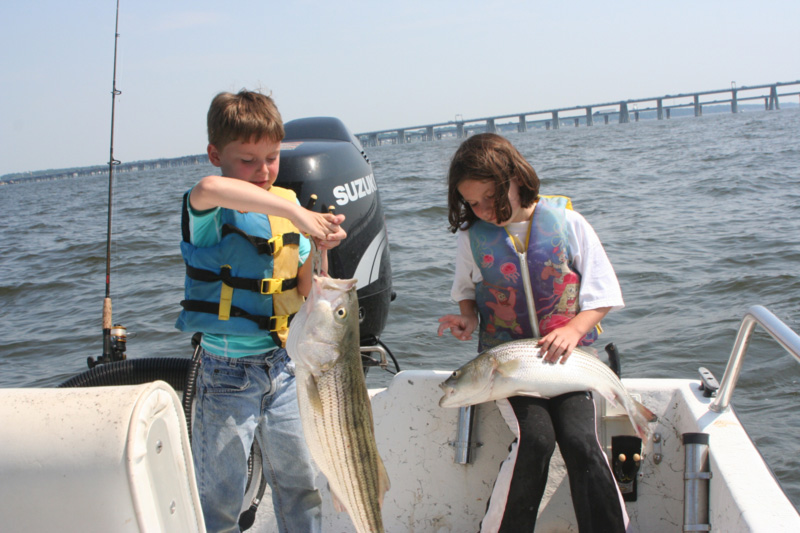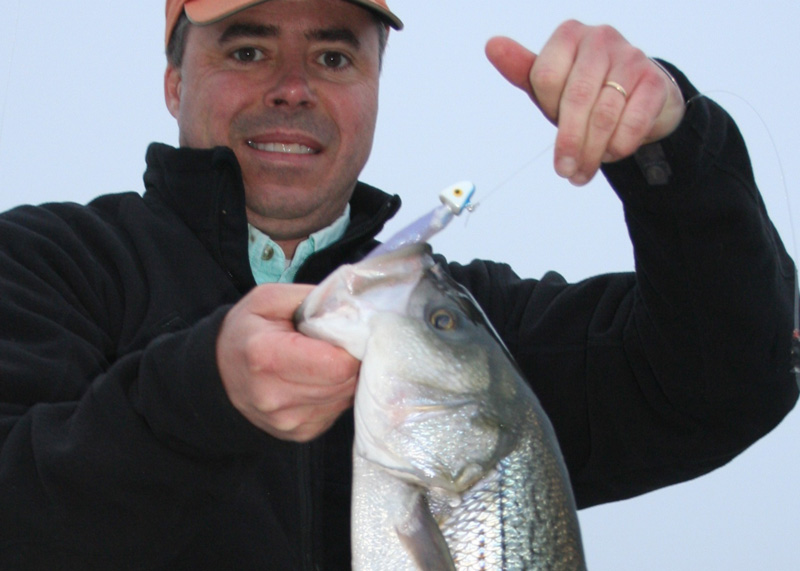The weather is warm, the fish are biting, and the world didn’t end in 2020 — what could be better? How about a surefire hotspot that holds fish each and every season at this time of year? That would be nice, but in the world of fishing there’s no such thing as a sure thing. There are, however, good bets. And one good bet for Upper Bay anglers is the Sewer Pipe.

Not Stinky
What exactly is the Sewer Pipe? According to the grapevine, it’s a (fully treated) sewerage outflow pipe that comes out from Kent Island, buried underground. It also says “sewer” on the charts in the general vicinity. Not being an expert in the sanitation department I can’t verify or deny this fact, but I have spoken to a diver who’s seen the bottom in this area, and evidently, it’s piled high with underwater rip-rap, cables, and lost anchors. I can verify the anchor thing, having donated two of my own to the reef structure here. And I can verify one other thing: rockfish love this spot.
The Sewer Pipe is located just an eighth of a mile or so north of the Bay Bridges, on the eastern side of the Bay, starting in 25 or so feet of water with diminishing depth as you head east. In several areas surrounded by deeper water the underwater rockpiles come up to 18 feet. The western edge of the spot is marked by a pair of orange and white floats, which is both a blessing and a curse: it makes the Sewer Pipe extremely easy to find, but these clear markings mean that anyone driving by can find it in a heartbeat. So, it gets hit pretty hard by anglers of all skill levels virtually every season. On the bright side, the area of uneven bottom in good depth runs several hundred feet, so running eastward from the floats multiple boats can fish it at once without crowding each other out. Plus, the close proximity of the Bay Bridges means you have a lot of options when fishing this area; you can hit the pipe itself, the shelf on its northern edge, the bridge pilings, and the bridge rockpiles, all in the same day. In fact, a good way to think of this spot is as an extension of the bridge itself — one more potential eastern-side hotspot to check out, even if it’s not quite connected to the bridge itself.
The Sewer Pipe and the rocks atop it form an east-west ridge which can hold fish on either side, or right on top. The shelf to the north of the Sewer Pipe, particularly the 22 to 28 foot depth zone, is just as important to bear in mind. Because of the rocks, cables, and snags galore, it’s essentially impossible to fish bait on bottom anywhere near the sewer pipe. It’s also practically impossible to anchor. Well, okay — actually, anchoring here is very, very easy. It’s getting your anchor back at the end of the day that’s impossible.
When jigging or trolling is taking fish, these anchoring issues don’t present too much of a problem as long as you’re careful. But what if chumming or live-lining is the hot tactic du jure? Option number-one is to creep north a hair, and anchor on that shelf just above it. This will allow you to get baits back to the structure on an outgoing tide. You’d think that on an incoming anchoring just south on this same ledge should prove effective, and for some folks maybe it is, but I’ve yet to experience a good bite in this scenario.

To anchor right among the rocks themselves, the trick is to leave the Danforth in the anchor locker and instead use a bendable wreck anchor that can get a grip in the rocks, but be bent free at the end of the day. (Handyman tip: weld three-foot-long lengths of rebar to the end of a section of pipe, and bend the three sections up into the shape of a grappling anchor). Even these can be tough to retrieve when entangled in lost rope, cables, and rocks. Another option that can be used on relatively calm days is to fill a paint bucket with cement and use it to hold your boat in place, or at least slow your movement to a crawl.
Move about a half-mile north of the markers and slightly to the west, and it’s possible to anchor up without snagging the bottom. And fish often do hold on this edge, even when you don’t necessarily catch them on the pipe itself. Chumming is particularly effective here, and will be best anywhere between 22 and 28 feet of water most days. When you approach the shelf, simply zig-zag from shallow to deep and vice versa, with an eye on the fishfinder. Wherever you see the most marks, settle in and start tossing the fish bits. Note: again, for some reason, this tactic is most effective in this spot during an outgoing tide. On an incoming it always seems meh, at best.
Tube Tactics
When fishing over the Sewer Pipe itself, jigging with soft plastics while on the drift is often a good bet. Once the lure taps bottom, reel in a touch, keep that lure just above it, and try not to bang the rocks too often. Even when fishing carefully, you’ll still lose plenty of lures here.
Another effective tactic for fishing these rocks is trolling diving plugs which run between 10 and 15 feet below the surface. These allow you to present your lures fairly close to the rockpiles without constantly snagging. Three-quarter ounce Rat-L-Traps in silver/blue patterns are a favorite for this, and they can be trolled with light spinning gear including from a kayak. Red/white Mir-O-Lure divers and Mann’s Stretch 10’s are also very good choices, but watch the Stretch 15’s — they’ll go deeper than 15 feet at times, and can easily end up as part of the reef.
When trolling these light lures on spinning tackle, keep your boat speed about as slow as you can stand it. If the lures are wobbling, you’re going fast enough, even if your GPS reads a paltry two mph. Shadowing the northern or southern edge of the ridge is usually the best bet; after a few passes you should get a read on which side the fish are hanging on and target it accordingly. Also remember to keep your spread light. This type of tackle is easy to tangle on the troll, since the light lines and lures can get blown out of position and are easily shoved around by the current or changes in boat direction. On most boats, four lines are all you’ll want to deploy in this scenario, in order to remain tangle-free.
You’ve hit the bridge pilings to no avail? Love Point has gone cold, and you need another Upper Bay option? Now’s the time to head for the Pipe, and take full advantage of your “Flush Tax.”
Sign up here to get the weekly FishTalk Chesapeake Bay and Mid-Atlantic fishing reports in your email inbox, every Friday by noon.